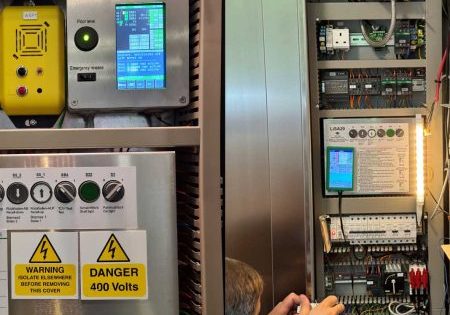What can a catalouge tell us?
The recent acquisition of a Keighley Lifts catalogue provides additional insights into the pre-World War II British vertical-transportation (VT) industry. However, prior to an investigation of the catalogue’s contents, the company’s origin and early history will be explored.
The Keighley Electrical Engineering Co., Ltd. was established in 1891 to “carry on the business of C.J. Garnett of South Street, Keighley, and to carry on the business of electrical engineers, suppliers of electric light, etc.”[1] By 1893, the company was described as ranking “among the most important of Yorkshire’s representative undertakings.”[2] The business was also described as being “ably conducted under the vigilant care and personal management of Mr. C.J. Garnett, whose acquaintance with all the high-class branches of electrical engineering extends over a lengthy period.”[2] The company focused on the production of a wide range of electrical equipment:
“They have been called upon to undertake the complete equipment of public and private residences, workshops and factories with the newest appliances. The Commercial Travellers’ Electric Clock, for hotels, lately brought out by the firm, is a marvel of scientific construction. The clock is fitted in the office of the hotel and communicates with each bedroom. Any traveller desirous of being called up at a certain time in the morning indicates his intention to the person in charge. The time is then specified on the clock, which when the proper interim expires, causes the bell in the bedroom to ring without ceasing until stopped by the occupant. The Company have also introduced many useful innovations in arc lighting, also in all departments of telephony, in burglar alarms, fire alarms, cold or frost alarms, elevator signals, annunciators and indicators, bells, lightning conductors, etc.”[2]
In 1899, the company merged with Messrs. Naylor & Holmes (Keighley):
“The two businesses will henceforth be carried on under the same management at the Vulcan Brass and Copper Works, by the style and title of the Keighley Electrical Engineering Co., Ltd. We are informed that the state of affairs is this: The lease of the Keighley Co. on their present premises, Alexander Works, Keighley, being about to expire, they have purchased the Vulcan Works of Messrs. Naylor & Holmes, of Keighley, together with their brass founding and finishing business which they will amalgamate with their own manufactures, and the Vulcan Works, to which the company is removing, are to be extended and additional plant put down to meet the requirements of rapidly increasing trade.”[3]
The first reference to lift manufacturing appeared the following year in an industry directory, which included the company’s name under the heading “Lifts (Electric) – Makers of.”[4]
However, as was evident in a description of the contents of a 1901 catalogue, lifts were only one of the many products they manufactured:
“The Keighley Electrical Engineering Co., Ltd., of Vulcan Works, Keighley, in a catalogue just issued, particularise their overtype and undertype dynamos, direct coupled steam sets, enclosed motors, open type multipolar ditto, motor transformers, electric hoists, switches and switchboards, fuse and junction boxes, and other electrical machinery and apparatus manufactured by them.”[5]
Six years later, their lift business had increased to the point that it warranted a dedicated 16-page brochure that gave “an illustrated account of their patent electric elevators, system of control, safety gear, etc.”[6] Given their early focus on designing and manufacturing electrical systems and equipment, the company was ideally suited to enter the growing electric lift marketplace and their business steadily grew in the 1920s and 1930s.
However, their increased focus on lift manufacturing did not result in a new company name until the mid-1940s. In February 1944, the Electrical Review reported that:
“In our issue of December 31st, we reported that Keighley’s (Lifts & Motors), Ltd., had been struck off the Register of Companies. The Keighley Electrical Engineering Co. (briefly known as ‘Keighley Lifts’) write to tell us that the company in question was merely a subsidiary of theirs which had never been actively worked; they themselves are still functioning as electric lift manufacturers. We are glad to clear up any misunderstanding there may have been.”[7]
In January 1945, Keighley Electrical Engineering Co., Ltd. finally (and officially) renamed itself Keighley Lifts, Ltd.[8] In an interesting business twist, in 1947, F. Francis and Sons (Deptford, London) acquired a controlling interest in Keighley Lifts. Francis and Sons was “confident that the link up of the two companies would be of great advantage. Although they were producing entirely different articles there were many ways in which both the works and the sales departments could co-operate.”[9] The stark differences in the two companies’ commercial interests were illustrated by an early 20th century account in which Francis and Sons was described as:
“Manufacturers of metallic casks and tin boxes; tinplate printers; (and) hollow ware stampers … Specialities: iron drums and kegs for oils, chemicals, etc., steel barrels, fancy tins, advertising tablets and trays, stamped retinned hollow ware, tuns and cans for paints, varnishes, enamels etc.”[10]
The Keighley catalogue examined for this article does not feature a publication date. However, the inclusion in the catalogue of references to lifts installed for 38 different clients permits an educated guess regarding when the catalogue appeared. The majority of the projects listed date from the mid- to late-1930s with the latest project completed in 1938. Thus, the catalogue was likely published in the late 1930s or early 1940s. The content of the 28-page catalogue was divided into three primary sections titled: “Where They Are Made,” “What They Are” and “Where They Are Installed.”[11]
The first section, “Where They Are Made,” provided an overall look into the world of lift design and manufacturing, and included the following introduction:
“It is our belief that any concern claiming right to the title ‘Lift Maker’ should, in fact, actually manufacture the equipment in his own works and not purchase components out from varying suppliers who obviously have but little interest in the goodwill which should exist between the purchaser and the supplier of the final product, i.e., the lift itself. With the exception of motors and wire ropes, every component which enters into the final construction of our product is manufactured at our modern and well-equipped works at Keighley in Yorkshire, and we are very happy at any time to extend an invitation to prospective buyers, architects or consulting engineers to pay us a visit and see our lifts in actual course of manufacture.”[11]
Readers were then taken on what today might be called a virtual tour of the Keighley works as seen through a series of photographs. The photographs included the design and drawing offices, car building shop, machine shop, controller assembly and electrical fitting shops, welding and sheet steel shops, and the woodworking shop (Figures 1 and 2).
Under the heading “Accurate and Tested,” a series of photographs depicted the inspection department, the temperature-controlled standard room, and workers engaged in hardness testing, plug gauge testing, gear and motor testing, worm and worm wheel testing, and worm concentricity testing (Figure 3). Under the heading “Made by Craftsmen,” nine photographs featured workers engaged in a variety of tasks including milling floor selector components, coil winding and turning grooves in traction sheaves (Figure 4). The final topic addressed in this section, titled “Social Amenities,” touched on the company’s appreciation for and support of their employees:
“It is the considered view of this company that the excellent workmanship for which it is so well known has been achieved as a result of the personal pride taken by the operatives in their work. This enthusiasm is reflected on the part of the company by the provision of excellent recreation facilities.”[11]
Two photographs were provided that depicted the employee’s “Welfare Club,” which was composed of a combined recreation and concert room (Figures 5 and 6). An examination of the photographs reveals a snooker table, ping-pong table, a small stage equipped with a piano and a small bar.
The introduction to the second section, “What They Are,” addressed Keighley’s approach to building electric lifts:
“Electric lifts have to embody all that is best from both a mechanical and electrical engineering point of view. We claim to be specialists in both fields, and we are one of the few concerns of lift makers in this country who actually manufacture all electrical control equipment. This is a matter of the greatest possible importance as it enables us to design both the mechanical and electrical equipment to operate in perfect harmony in order to provide smooth and efficient operation.”[11]
Keighley’s lift production was divided into five categories: passenger lifts, goods lifts, service lifts, hospital lifts and motor car lifts. The catalogue described and illustrated a typical driving unit, electrical switchgear, operating equipment, locking equipment and safety equipment (Figures 7 and 8). The nature of the technical information included in the catalogue may be illustrated by the description of their electrical switchgear or controller:
“Silence, efficiency and robust construction are the keynote in our latest design of controllers. Direction contactors are fully interlocked and have copper-to-carbon main contacts of ample proportions. Accelerator contactors have copper-to-copper contacts, and the whole is mounted on the highest-grade insulating panels in such a way that access to both front and back is readily available in either the open or closed types. Where electrical supply is A.C., magnets are energised by direct current through the medium of a metal rectifier.”[11]
This description was accompanied by five photographs (Figure 9) that depicted:
“A control panel arranged for ‘Up, Down and Stop’ or ‘Car Switch’ control … a fully automatic push button controller interlocked in order to render the panel completely safe when the glazed doors are open … (an) automatic floor selector complete with floor relays, which is built into the controller, and is operated by an inductor on the car top, thus avoiding interconnecting wiring and eliminating the noise which is normally associated with mechanically operated selectors. It will be appreciated that the incorporation of this electrically operated inductor floor selecting device eliminates all rubbing contacts … (and a) car limit switch operated by ramps in the well working on rubber-tyred roller levers in order to ensure quietness.”[11]
This section of the catalogue also featured descriptions and photographs of the company’s custom goods and passenger lift cars. The passenger car design names included Ely, Essex, Sussex, and Ripon (a combined passenger and goods car) (Figure 10).
The introduction to the third section of the catalogue, “Where They Are Installed,” noted that:
“The small selection of photographs which follow give some idea of typical buildings in which our lifts operate. Some of our more recent installations have been carried out in the largest Power Stations in the country, and we are in a position to demonstrate lifts working in all types of factories, warehouses, hotels, blocks of flats, hospitals, office buildings, cotton and woollen mills, etc. One interesting contract was carried out by us in 1938 when we installed 88 passenger lifts in a single block of industrial flats at Quarry Hill, Leeds, since which date the lifts have made millions of passenger-journeys in complete safety and to the satisfaction of the Leeds Corporation Housing Department. There are sure to be some Keighley lifts in your town.”[11]
The photographs were presented in geographical groupings, illustrating projects in the following “areas”: Leeds, London, Manchester, Bristol and Birmingham. In addition to the flats at Quarry Hill (one of the U.K.’s first large public housing estates), other notable installations included providing 160 lifts for Woolworth Stores located throughout the U.K. (In 1934, “the six hundredth British Woolworth opened in Wallington, Surrey, just four years after the four hundredth in Southport, Lancashire.”[12]) Two other installations of note (and evidence of particularly British culinary tastes) included three lifts provided for the Marmite Food Extract Co., Ltd. (London) and two lifts provided for the Smith’s Potato Crisps factory (Swansea).
The catalogue concluded with a brief description of Keighley’s “After-Installation Service,” a service that resembled those provided by other lift manufacturers:
“To ensure that electric lifts provide that uninterrupted and trouble-free service which our clients have a right to expect, we have a comprehensive maintenance service operating over the whole of the country. Under this arrangement we send OUR OWN ENGINEERS at regular intervals to clean, lubricate and thoroughly overhaul every installation. Only skilled craftsmen are employed on this work, thus ensuring your lifts being kept in the best possible condition, and by this means, keeping operating costs down to an absolute minimum, and at the same time providing complete safety of operation. Each one of our District Offices is equipped with complete maintenance staff and supervisor. We shall be very happy to send full details of our extensive maintenance service on request.”
The contents of the Keighley catalogue illustrate the state-of-the art in electric lift design in the 1930s, as well as the gradually changing U.K. urban landscape, with the appearance of large public housing projects designed in modern architectural styles. Future articles will examine the development of “modern” lifts designed to suit modern architectural environments, as well as the role the VT industry played in rebuilding cities across the U.K. during the post-World War II period.
References
[1] “New Companies Registered,” The Electrical Review (1 January 1892).
[2] The Century’s Progress, Yorkshire, The London Printing & Engraving Co. (1893).
[3] “Trade Announcements,” The Electrical Review (5 May 1899).
[4] J.A. Berly’s Universal Electrical Directory and Advertiser, London: H. Alabaster, Gatehouse & Co. (1900).
[5] “Catalogues and Lists,” The Electrical Review (15 February 1901).
[6] “Catalogues and Lists,” The Electrical Review (21 June 1907).
[7] “Keighley Lifts,” The Electrical Review (18 February 1944).
[8] “Companies’ Returns,” The Electrical Review (25 May 1945).
[9] “F. Francis and Sons,” The Spectator (20 June 1947).
[10] Grace’s Guide to British Industrial History: Whitaker’s Red Book of Commerce (1914).
[11] Keighley Lifts Ltd. catalogue, Vulcan Works, Dalton Lane, Keighley, Yorkshire (c. 1950)
[12] woolworthsmuseum.co.uk.
Get more of Elevator World. Sign up for our free e-newsletter.









